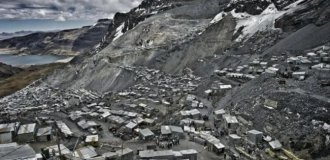R/V "Cosmonaut Yuri Gagarin" - a ghost of former greatness (101 photos)
Good afternoon Good afternoon, dear friends and visitors of the PPP club. Club of Travel, Knowledge and Adventure. Today we will travel back in time again. Our time machine is constantly being improved. And today we will probably have one. the longest excursion into the past. Ready? Fasten seat belts! Launch!
The R/V "Cosmonaut Yuri Gagarin" is the largest and most powerful expedition vessel in terms of scientific and technical equipment.

Gagarin compared to the Titanic.

This is what this Flagship of the Soviet Marine Space Fleet was like. A wonderful photo album about this ship has been preserved. Let's look through it!



































































































Here you go, gentlemen. You and I have turned the last page of this album.
In order not to bore you with another picture, I will simply reprint what is written on the last page, let's say thank you to these people.
NAMED AFTER THE WORLD'S FIRST COSMONAUT
catalog
They were working on its creation.
Scientific editors P. F. Vanyaushin, D. G. Sokolov
Responsible for the release is L. G. Vasiliev.
Photos by L. G. Heifetz, V. I. Kuznetsov,
R.S. Kirakasyants
Art editors. I.I. Litomin, K.A. Karposhevich
Technical editor M. G. Bogdanova.
The catalog contains 105 sheets, 135 photographs.
Signed for publication on 31/III-72.
Circulation 50 copies. For free. Issue No. 98. Type. zak. 296
Reading these seemingly simple technical dаta: "Circulation 50 copies. Free. Edition No. 98. Type order. 296." Think about it. how many people worked to print only 50 FIFTY!!! copies of this interesting catalogue. It was distributed for FREE. But what kind of distribution is there...
And only thanks to the enthusiast O. Pavlenko we can get acquainted with this bibliographic rarity. Let's say a special thank you to him.
What happened to this ship next?
1996 In Odessa, in the port of Yuzhny, an extraordinary ship stood alone at the pier. On its side could be seen the strange name "AGAR", which did not say anything to those who first saw the steel giant, which arrived from somewhere from the great past. This was our flagship, the best scientific vessel in the country and, perhaps, in the world. How did it get here? In 1991, "Cosmonaut Yuri Gagarin"
the main expedition left him. After the collapse of the Union and the reduction of space programs, astronautics experienced a very difficult time - it found itself out of work. One of the main symbols of the space flotilla, the R/V Gagarin was now a terrible sight: rusted, desecrated by vandals, littered and looted. The Marine Space Fleet was completely disbanded in 1995. In 1991, Gagarin was privatized by Ukraine, and soon titanium was unaffordable for the Black Sea Shipping Company. It is still unknown what happened to the ship’s library and museum, where the portrait of Yu. Gagarin, donated to the crew by Anna Timofeevna Gagarina, disappeared. In 1996, Cosmonaut Yuri Gagarin was sold for $170 per ton. It was a shame to sell scientific pride for scrap metal, so the name of the ship was covered with paint, leaving only the letters “AGAR”. “Cosmonaut Yuri Gagarin”, who completed 22 expeditionary flights, set off on his last journey to India. There, in the port of Alang, in a matter of days it was cut into large, shapeless pieces. Perhaps this metal will return to us in the form of pots or souvenir badges, or in the form of other ships, but no one will know about it. Today, only one ship remains from the entire IFF - “Cosmonaut Viktor Patsayev”, it is located in the port of Kaliningrad, at the pier of the “Museum of the World Ocean”. Sometimes it is involved in work on the ISS - it conducts periodic communication sessions. But he doesn’t go out to sea, he’s “on a leash.”
Today, many countries around the world have ships built to monitor space. The USA and France have several, China is constantly expanding its space fleet: our eastern neighbors already have 5 specialized ships equipped with systems for receiving telemetry and controlling spacecraft. Without a large network of NPCs and foreign bases, the Chinese understand perfectly well
— for the development of astronautics, they vitally need IFF vessels.
Many thanks to EVERYONE who read this publication to the end. And see you again in the PPP club!
























